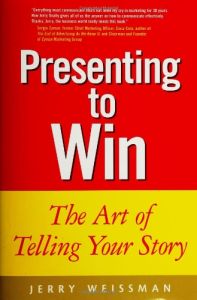Join getAbstract to access the summary!

Join getAbstract to access the summary!
Jerry Weissman
Presenting to Win
The Art of Telling Your Story
FT Prentice Hall, 2003
What's inside?
When you tell your story, focus on what you want your audience to do, and why. Show how they benefit to get your way.
Recommendation
The lessons in this excellent book should be studied and applied by everyone who has to give presentations. In terms of audience connection and persuasive technique, Abe Lincoln must have known everything here (except, perhaps, the details of PowerPoint). And that’s good, because you don’t need anything new or fancy to give a great presentation, you just need a message and clear instructions on how to deliver it - so, here they are. The book is cleanly written with pop-out boxes, sample graphics and corporate examples. Anyone who ignores its powerful basic rules will fail at presenting. Failure means boring the audience and leaving them unconvinced and unwilling to hear more. This is your cure for those blues. The book’s flaw is the author’s tedious self-promotion, but he’s a former TV guy, so what the heck do you expect? The bottom line, getAbstract attests, is that what he says, you need to know.
Summary
About the Author
Jerry Weissman has coached the top brass at Yahoo!, Compaq, Intel, Intuit, Cisco Systems, Microsoft and almost 400 other client firms about how to do important business presentations and road shows that have raised billions in the stock market. He is a former news and public affairs producer for CBS Television.


















Comment on this summary